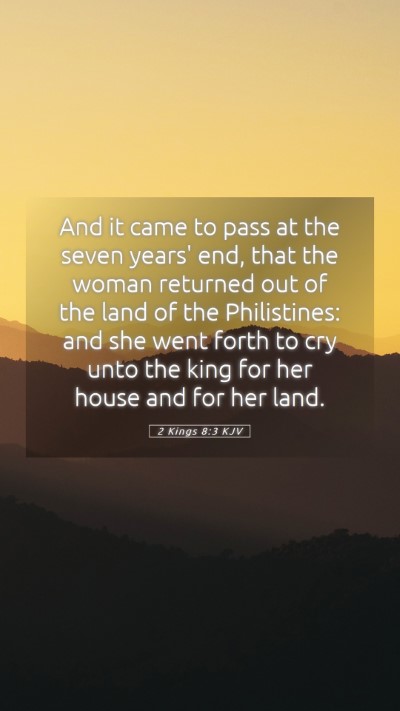Understanding 2 Kings 8:3: A Comprehensive Bible Verse Commentary
In this analysis, we will explore the meaning and significance of 2 Kings 8:3 through a combination of insights derived from esteemed public domain commentaries, including those by Matthew Henry, Albert Barnes, and Adam Clarke. This verse reads: "And it came to pass at the end of seven years, that the woman returned out of the land of the Philistines: and she went forth to cry unto the king for her house and for her land."
Contextual Overview
The Book of 2 Kings narrates the history of Israel and Judah following the reign of King David. It serves as a historical record that showcases the lives of various kings and the prophetic activities during their reigns. Chapter 8 is significant as it tells the story of a woman from Shunem, who had previously been blessed by Elisha. After a time away due to famine, she returns to claim her property, highlighting themes of restoration and God's provision.
Analysis of the Verse
To fully understand 2 Kings 8:3, we will break it down into several components as interpreted by the noted commentators:
-
Time Frame:
Matthew Henry reflects on the significance of the seven years indicating a complete period during which the woman was away. This duration symbolizes God's timing in the affairs of life and restoration.
-
The Woman's Return:
Albert Barnes emphasizes the bravery and determination of the Shunammite woman, illustrating that despite hardship, she returns to claim what was rightfully hers. This act signifies hope and the possibility of reclaiming lost blessings after adversity.
-
Crying to the King:
Adam Clarke notes that her appeal to the king reflects the importance of seeking justice in the face of loss. The act of crying out indicates her desperation and the rightful pursuit of her blessings, resonating with the Biblical principle of petitioning authority.
Key Themes
The exploration of this verse reveals several key themes important for understanding its implications:
-
Divine Restoration:
This verse speaks volumes about God's faithfulness in restoring what has been taken away. The woman’s return portrays a biblical principle that aligns with the idea of restoration promised within the Scriptures.
-
Seeking Justice:
The woman’s move to approach the king signifies the importance of seeking justice in times of personal loss. This serves as a reminder to believers about the importance of advocating for oneself through appropriate channels.
-
The Role of Prophetic Guidance:
This verse connects to the larger narrative of Elisha’s ministry, illustrating how prophetic figures play a crucial role in guiding individuals through trials and tribulations, as seen in similar passages throughout the scriptures.
Cross References
Several other verses complement the understanding of 2 Kings 8:3:
- 2 Kings 4:8-37: The story of the Shunammite woman and her son, connecting her past blessings to her current situation.
- 1 Kings 17:8-16: The account of Elijah and the widow of Zarephath, showcasing God’s provision during times of famine.
- Psalm 126:1-3: A reflection on the joy of restoration after periods of captivity, similar in spirit to the woman’s narrative.
Conclusion
In summary, 2 Kings 8:3 encapsulates profound themes of restoration, justice, and God’s providential care woven throughout the fabric of the Old Testament narrative. As you delve into the meanings of Bible verses like this, consider the context, historical background, and theological implications. This level of Bible verse study not only enriches personal faith but equips individuals for sharing insights within Bible study groups and online Bible study contexts.
Further Study Resources
For those interested in further exploration of Biblical texts and themes, consider utilizing the following Bible study tools:
- Bible Study Guides: Look for guides that provide detailed commentary and context for various Bible verses.
- Bible Study Lessons: Engage with lessons that challenge you to apply the scriptures to your daily life.
- Bible Study Courses: Enroll in courses that offer systematic study methods, helping to interpret difficult passages.


